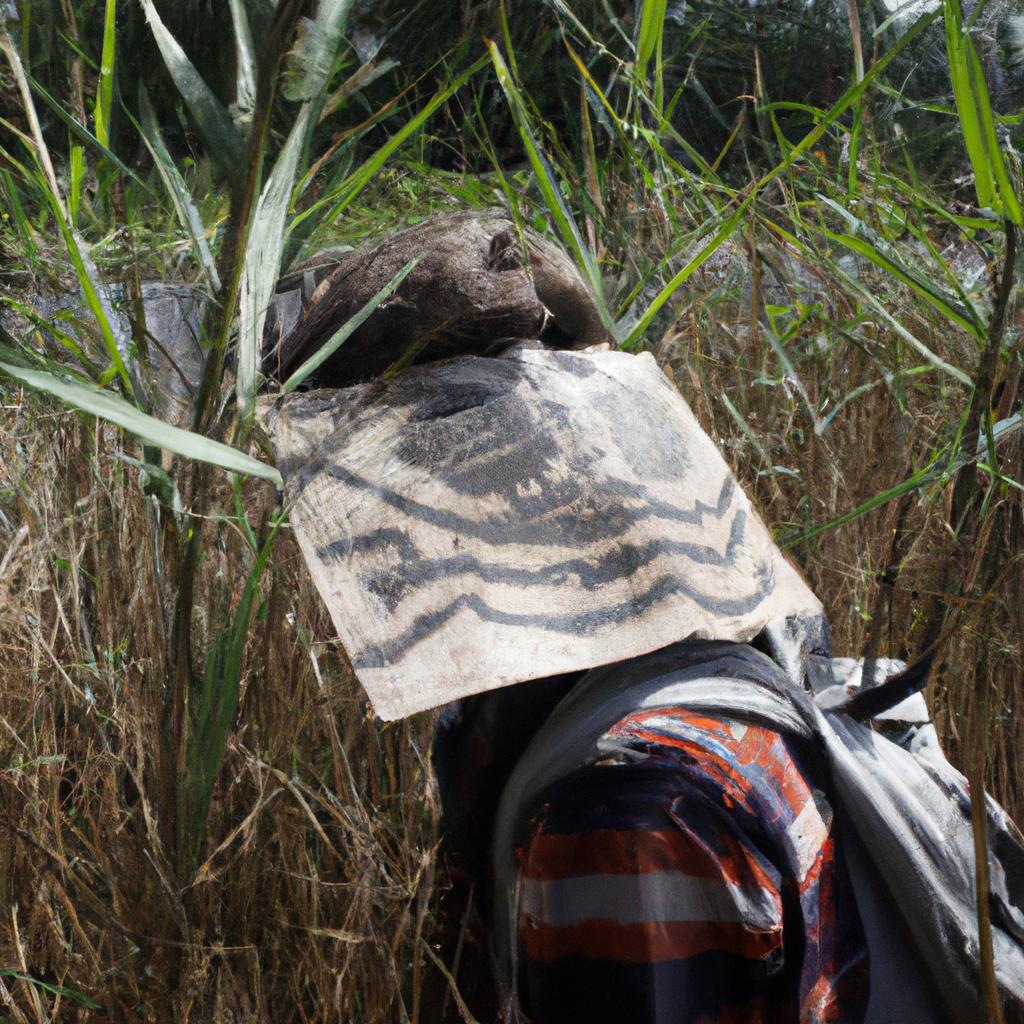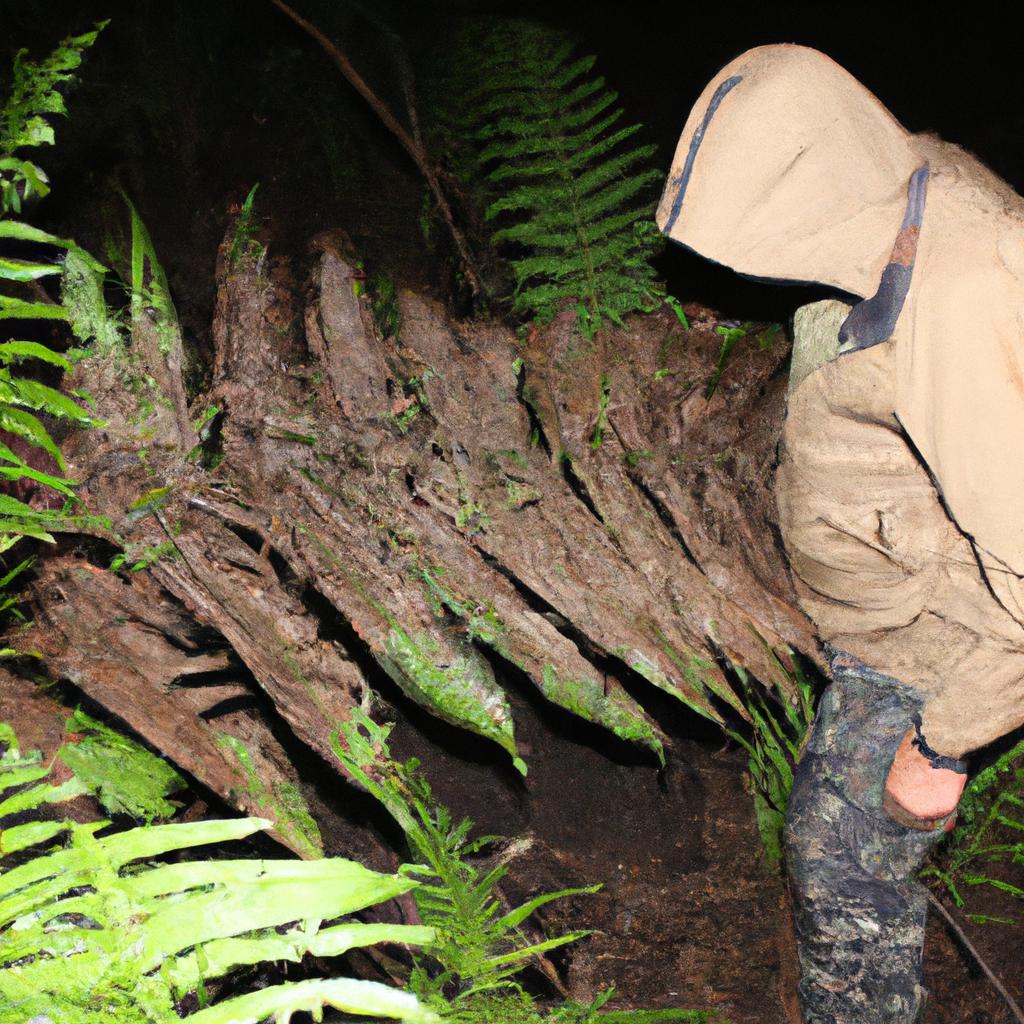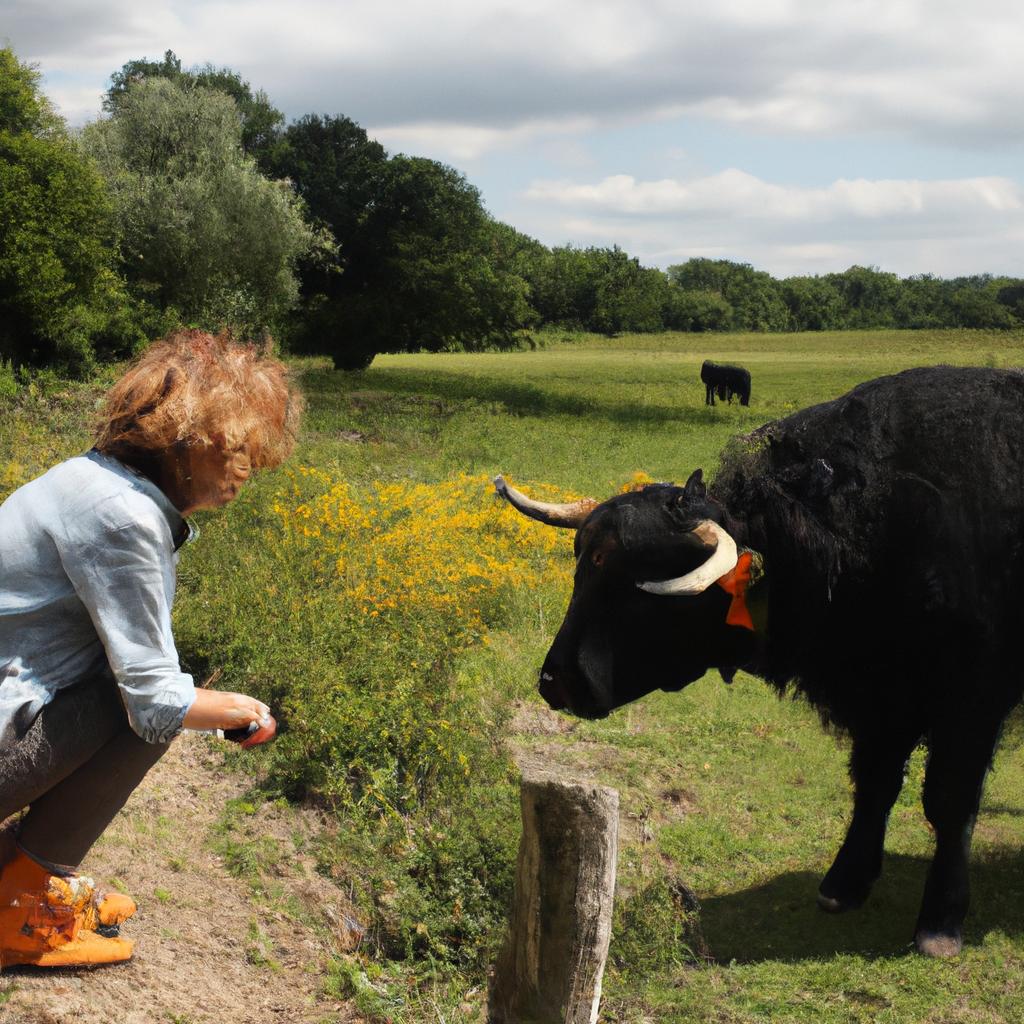Countershading is a fascinating phenomenon found across various species in the natural world. This camouflaging technique involves dark coloration on the upper side of an organism’s body and lighter coloring on its underside, creating an optical illusion that helps it blend seamlessly with its environment. One example of countershading can be observed in marine creatures such as sharks. The dorsal (upper) side of a shark typically exhibits darker pigmentation while the ventral (lower) side appears to be lighter, aiding them in evading detection by predators or prey.
Understanding countershading holds significant importance in the realm of natural history as it highlights nature’s remarkable ability to adapt and survive within diverse ecosystems. By effectively concealing an organism’s shape and presence, this camouflage strategy provides both defensive benefits – enabling animals to avoid predation – and offensive advantages – allowing for more successful hunting endeavors. Countershading has been studied extensively among various taxa ranging from terrestrial mammals like deer, which exhibit contrasting coat colors, to avian species such as penguins, known for their distinctive black backs and white bellies. Through investigating the mechanisms behind this concealment tactic, scientists can deepen their understanding of evolutionary processes and gain insights into how different organisms have adapted over time to maximize their chances of maximizing their chances of survival and reproductive success in their respective environments.
Additionally, the study of countershading can have practical applications in fields such as military camouflage design and robotics. By mimicking nature’s effective concealment strategies, designers can develop more efficient and adaptive camouflage patterns for soldiers or create robots that blend seamlessly into their surroundings for surveillance or search-and-rescue missions.
Overall, the phenomenon of countershading is a fascinating adaptation that showcases the ingenuity of nature and provides valuable insights into how organisms have evolved to thrive in their habitats while remaining hidden from potential threats.
Definition of countershading
Countershading is a common camouflage technique found in various animal species. It involves the use of coloration to create an optical illusion that helps animals blend into their surroundings and avoid detection by predators or prey. This adaptive strategy has been observed in diverse habitats, ranging from terrestrial to aquatic environments.
To illustrate this concept, let us consider the case of a gazelle living on the African savannah. The gazelle’s upper body fur is darker than its lower body fur. When viewed from above, the dark upper body blends with the shadows cast by tall grasses and shrubs, making it difficult for predators such as lions or cheetahs to spot them. Conversely, when viewed from below against the bright sky, the lighter underbelly matches the brightness of the sunlight, further enhancing its camouflage and reducing its visibility.
The effectiveness of countershading can be understood through several key points:
- Enhanced survival: By blending seamlessly into their environment, animals employing countershading gain a distinct advantage over those lacking this adaptation.
- Reduced predation risk: Countershading makes it harder for predators to detect potential prey due to color patterns that disrupt visual cues.
- Improved hunting efficiency: For animals that are predators themselves, countershading aids in stealthily approaching unsuspecting prey.
- Increased reproductive success: Individuals with effective countershading are more likely to survive long enough to reproduce successfully and pass on these advantageous traits to future generations.
| Advantages of Countershading |
|---|
| Enhanced survival |
In conclusion, countershading is a widely observed phenomenon across different animal species and habitats. Its ability to provide effective camouflage plays a vital role in ensuring an individual’s survival by minimizing both predation risk and exposure during hunting activities. In the following section, we will explore specific examples of countershading in various animal species, further highlighting the versatility and significance of this remarkable adaptation.
Examples of countershading in different animal species
Countershading is a fascinating camouflaging technique found in various animal species. This adaptive coloration strategy involves having darker pigmentation on the upper side of an organism’s body and lighter pigmentation on its underside. By employing this unique pattern, animals can effectively blend into their surroundings and enhance their chances of survival.
To better understand how countershading works, let us consider the example of the African lion (Panthera leo). The lion’s coat exhibits countershading, with its back being covered in tawny-colored fur while its belly appears much lighter. This color gradient helps the lion to conceal itself when stalking prey or lying low in grassy habitats such as savannahs. By breaking up its silhouette against different light conditions, the lion becomes less noticeable to both potential prey and predators.
The benefits of countershading extend beyond lions. Various animal species have evolved similar mechanisms for camouflage through countershading. Here are some key advantages associated with this remarkable adaptation:
- Concealment: Countershading enables animals to blend seamlessly into their environment by matching the lighting conditions from above and below.
- Disruption: The contrasting colors provided by counter-shaded patterns help break up an animal’s outline, making it difficult for predators or prey to detect them.
- Illusion: Countershading creates an optical illusion that alters an observer’s perception of depth and shape, further aiding in concealing an animal’s presence.
- Protection: By minimizing visual cues like shadows or highlights created by ambient light, countershaded animals can reduce their visibility and avoid potential threats.
| Advantages of Countershading |
|---|
| Concealment |
| Disruption |
| Illusion |
| Protection |
In summary, countershading is a highly effective camouflaging technique observed across numerous animal species. Through blending into their environments by utilizing differences in pigmentation across their bodies, these organisms gain a significant advantage in terms of concealment and protection. In the following section, we will explore the specific advantages countershading provides to different animal species, further highlighting its importance as an adaptive strategy for survival.
Advantages of countershading as a camouflaging technique
Section H2: Advantages of Countershading as a Camouflaging Technique
The previous section explored various animal species that exhibit countershading, demonstrating its effectiveness as a camouflaging technique. Now, we will delve into the advantages offered by countershading and how it enhances an organism’s survival in different environments.
To illustrate these advantages, let us consider the hypothetical case study of a small mammal living in a dense forest habitat. This creature possesses countershading, with darker pigmentation on its dorsal side and lighter coloration on its ventral side. As this mammal moves through the undergrowth, encountering patches of sunlight filtering through the canopy above, its countershading provides several benefits:
-
Concealment from predators: The contrasting colors created by countershading help break up the animal’s body outline, making it less conspicuous against varying light conditions. When illuminated from above, the dark dorsal side blends seamlessly with shadows cast below, while the lighter ventral side matches the brightness of diffuse light penetrating from above.
-
Disruption of depth perception: Countershading can create optical illusions that deceive potential predators regarding an animal’s distance or size. The gradual transition between dark and light areas confuses visual cues used for estimating depth, making it challenging to accurately perceive the animal’s position within its surroundings.
-
Thermoregulation: In our hypothetical case study, being able to regulate body temperature is crucial for our small mammal’s survival in the fluctuating forest environment. The dark pigment on its dorsal side absorbs more heat when exposed to direct sunlight but helps warm their bodies during cooler periods. Conversely, the lighter ventral side aids in reflecting excess heat away and prevents overheating.
-
Mimicry opportunities: Countershading has also been observed to serve as a foundation for mimicry adaptations in certain animals. Some species take advantage of their natural shading patterns to resemble objects or organisms in their environment, further enhancing their ability to blend in and avoid detection.
To emphasize the advantages provided by countershading, consider the following table:
| Advantages of Countershading |
|---|
| Concealment from predators |
| Disruption of depth perception |
| Thermoregulation |
| Mimicry opportunities |
As we have seen, countershading offers a range of benefits for organisms across different habitats. By effectively blending with their surroundings and influencing visual perceptions, animals employing this camouflage technique gain a survival advantage. In the subsequent section about “The science behind how countershading works,” we will explore the underlying mechanisms that allow countershading to function so effectively.
The science behind how countershading works
Now, let us delve deeper into the science behind how countershading works and explore its effectiveness in various natural habitats.
Countershading is a camouflaging strategy that involves having darker pigmentation on the upper side of an animal’s body and lighter pigmentation on the underside. This coloration helps to create an optical illusion that minimizes the chances of detection by predators or prey. To illustrate this concept further, consider the example of a deer species found in dense forests.
In such an environment, where sunlight filters through tree canopies unevenly, countershading aids in breaking up the deer’s outline against the background. When standing beneath dappled light, with patches of brightness and shadow playing across its body, the deer’s dark dorsal surface blends seamlessly with shadows cast from above, while its lighter ventral surface merges with beams of sunlight filtering through gaps in foliage below. Consequently, it becomes challenging for predators like wolves or mountain lions to discern individual animals from their surroundings.
The efficacy of countershading as a camouflage mechanism can be attributed to several factors:
- Disrupting body shape: The contrasting colors created by countershading help break up an animal’s silhouette, making it harder for predators or prey to identify its true form.
- Reducing contrast cues: Countershading reduces abrupt changes between different areas of an animal’s body, making it less conspicuous against complex backgrounds.
- Minimizing shading effects: By having darker pigmentation on top and lighter pigmentation underneath, countershaded animals appear more uniformly illuminated under varying lighting conditions.
- Confusing depth perception: The interplay between light and dark shades caused by countershading creates visual illusions that make it difficult for predators or prey to accurately judge distance or location.
To emphasize these advantages visually, we present a table highlighting some examples of animals utilizing countershading in different habitats:
| Animal | Habitat | Countershading Adaptation |
|---|---|---|
| Snowshoe hare | Arctic tundra | White fur on the underside, dark fur on the back |
| Leopard | African savannah | Spotted coat aids in blending into dappled sunlight |
| Atlantic puffin | Oceanic cliffs | Black upper body and white underbelly for seabed camouflage |
| Green tree python | Rainforest canopy | Lighter ventral scales blend with patches of light filtering through leaves |
Understanding how countershading works provides valuable insights into animal adaptations to their environments. In the subsequent section, we will explore evolutionary theories explaining the development of countershading, shedding light on its emergence and persistence throughout natural history.
Evolutionary theories explaining the development of countershading
Countershading is a remarkable evolutionary adaptation that provides animals with the ability to blend seamlessly into their surroundings. This camouflage technique, observed in numerous species across the natural world, plays a crucial role in survival by reducing an individual’s detectability and increasing its chances of escaping predation. To further explore this fascinating phenomenon, we will delve into some key theories explaining the development of countershading and examine how it functions as a vital defense mechanism.
One intriguing example illustrating the effectiveness of countershading can be found in the oceanic realm. Consider the case of the Atlantic bluefin tuna (Thunnus thynnus), a highly prized fish known for its incredible agility and speed. Despite being one of nature’s fastest swimmers, this magnificent creature relies on countershading to remain inconspicuous amidst varying depths and lighting conditions. Its dorsal side features a dark shade while its ventral side boasts a lighter hue, effectively creating an optical illusion that camouflages it from both above and below when viewed against open water or sunlight filtering through waves.
The success of countershading lies in several adaptive advantages it confers upon organisms:
- Concealment: By contrasting their upper parts against brighter backgrounds and lower parts against darker backgrounds, counter-shaded animals are able to break up their body outlines effectively, making them less noticeable to potential predators.
- Disruption: The gradation in coloration along an animal’s body disrupts its perceived shape, thus rendering it more difficult for predators to recognize prey items or potential threats.
- Illusionary depth: Countershaded individuals appear flatter than they actually are due to light absorption differences between their dorsal and ventral sides. This visual distortion makes it challenging for predators to accurately judge distance or size.
- Confusion effect: When multiple counter-shaded animals congregate together, such as in schools or herds, their collective color patterns create a visual confusion for predators, making it harder to single out and attack individual prey.
To fully comprehend the significance of countershading across diverse species, we can examine some notable examples in nature:
| Species | Habitat | Countershading Adaptation |
|---|---|---|
| Arctic fox | Snow-covered environments | Dark dorsal side and white ventral side aid in blending with snowy landscapes. |
| African elephant | Savannah grasslands | Shadowed undersides combined with light-colored upper parts help conceal their massive bodies amidst tall grasses. |
| Leopard seal | Antarctic waters | Light belly camouflages against icy surfaces when viewed from below, while dark back provides camouflage against open water or from above. |
| Bobcat | Forested regions | Mottled fur pattern assists in concealing its presence among dense foliage and fallen leaves. |
As we delve deeper into understanding the mechanisms behind countershading, we will uncover how this natural phenomenon inspires human applications in design and fashion. By harnessing the principles of countershading, innovative creations arise that blend artistry with functionality, providing us with an intriguing glimpse into the potential intersections between biology and human ingenuity.
Human applications of countershading in design and fashion
Evolutionary theories have shed light on the development of countershading, a fascinating camouflage technique employed by various organisms in nature. As discussed earlier, countershading is thought to have evolved as a response to predation pressures and has been observed in numerous species across different habitats. Now, let us delve into how humans have applied this concept of countershading in design and fashion.
One intriguing example of human application can be found in the field of military technology. In an effort to enhance concealment and reduce visibility, researchers have explored incorporating countershading techniques into uniforms and equipment used by soldiers in combat zones. By employing colors that blend with the surrounding environment, such as darker shades at the top and lighter tones towards the bottom, these designs aim to disrupt the perception of depth and make individuals less detectable from afar.
- Enhancing athletic performance: Sportswear designers have experimented with integrating countershading patterns into clothing worn by athletes during outdoor activities. The strategic use of color gradients helps create an illusion of movement, making it harder for opponents or predators to anticipate their trajectory.
- Promoting body positivity: Fashion brands are increasingly embracing diversity and inclusivity by utilizing countershading principles in their garment designs. By accentuating certain areas while minimizing others through clever shading techniques, designers can help individuals feel more comfortable and confident in their own bodies.
- Reducing visual clutter: In interior design, applying countershading concepts can aid in creating visually pleasing spaces devoid of unnecessary distractions. By using color variations that mimic natural lighting conditions, designers can promote relaxation and focus within a given environment.
- Influencing emotional responses: Countershading techniques also find applications beyond aesthetics. For instance, psychologists explore implementing subtle shading variations in therapy rooms to evoke specific emotions or induce a sense of calmness during counseling sessions.
In addition to these practical applications, the concept of countershading in design and fashion can be summarized in the following table:
| Application | Description |
|---|---|
| Military technology | Integration of countershading techniques into uniforms and equipment for enhanced concealment. |
| Sportswear | Utilizing countershading patterns to improve athletic performance and disrupt opponents’ predictions. |
| Body positivity | Designing garments with shading techniques that promote self-confidence and inclusivity. |
| Interior design | Applying countershading principles to create visually appealing spaces conducive to relaxation and focus. |
By exploring various realms such as military technology, sportswear, body positivity, interior design, and emotional responses, it becomes evident that the application of countershading concepts extends beyond mere aesthetics. These innovative adaptations draw inspiration from nature’s remarkable strategies while simultaneously addressing human needs and desires. The potential for further exploration in this area holds promise not only for functional improvements but also for fostering positive emotional experiences within different domains.




